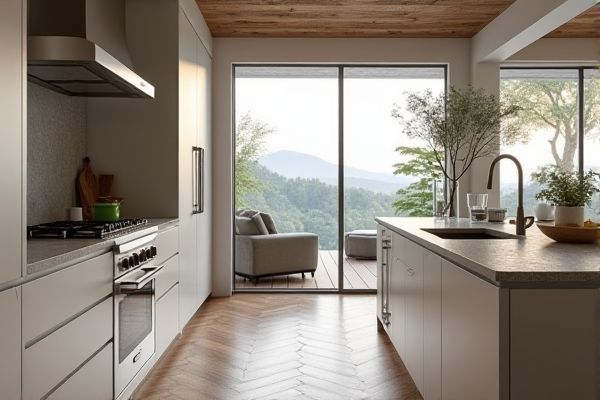
Choosing between a free-standing range and a slide-in range depends on your kitchen layout and design preferences, as free-standing ranges offer versatility and easy installation while slide-in ranges provide a seamless, built-in look with a continuous countertop flow. Explore the rest of the article to find out which option best suits your cooking style and aesthetic needs.
Table of Comparison
| Feature | Free-Standing Range | Slide-In Range |
|---|---|---|
| Installation | Easy to install, fits between cabinets or walls. | Built-in look, installed flush with countertops and cabinets. |
| Design | Visible rear backguard with controls. | Controls at front; sleek, seamless appearance. |
| Customization | Limited integration with cabinetry. | Custom fit for specific cabinet dimensions. |
| Cost | Generally more affordable. | Tends to be higher priced due to design and installation. |
| Cleaning | Backguard can collect dust; edges may be harder to clean. | Smoother edges; easier to wipe down. |
| Space Efficiency | Requires clearance around range for ventilation. | Maximizes kitchen space with built-in installation. |
| Control Access | Controls at rear; may be less accessible. | Front controls for safer, easier access. |
Introduction to Free-Standing and Slide-In Ranges
Free-standing ranges feature finished sides and can be installed anywhere in the kitchen, providing versatility and easy placement. Slide-in ranges are designed to fit flush between cabinets, offering a seamless, built-in look with controls located on the front for added convenience. Choosing between these types depends on kitchen layout preferences and installation flexibility.
Key Differences Between Free-Standing and Slide-In Ranges
Free-standing ranges feature finished sides and can be placed anywhere in your kitchen, offering versatile installation options with a traditional look, while slide-in ranges have a seamless, built-in appearance designed to fit flush with countertops and cabinets for a more integrated design. Slide-in ranges often provide a more stylish, modern aesthetic with controls located on the front panel for easy access, whereas free-standing models typically have controls on the back panel. Your choice depends on kitchen layout preferences, desired aesthetics, and whether you prioritize ease of installation or a sleek, custom look.
Design and Aesthetic Appeal
Free-standing ranges offer versatile placement options with finished sides and a backguard, making them ideal for kitchens where the range is positioned away from cabinets. Slide-in ranges provide a seamless, built-in look with controls on the front, allowing them to blend flush with countertops and cabinetry for a sleek, modern aesthetic. Choosing the right design ensures Your kitchen maintains a cohesive and visually appealing layout tailored to Your style preferences.
Installation Requirements and Flexibility
Free-standing ranges require minimal installation effort, simply sliding into place with existing gas or electrical connections, offering maximum flexibility to reposition or replace without modifications. Slide-in ranges demand more precise fitting, often requiring built-in cabinetry alignment for a seamless countertop look, limiting relocation options due to fixed installation. Your choice hinges on whether ease of installation or integrated kitchen design is the priority.
Cost Comparison: Which Is More Budget-Friendly?
Free-standing ranges generally offer a more budget-friendly option compared to slide-in ranges, with prices typically ranging from $400 to $1,500 depending on brand and features. Slide-in ranges, designed for a seamless, built-in look, usually start around $1,000 and can exceed $3,000, reflecting their premium build and customization options. Homeowners prioritizing affordability often lean toward free-standing models due to lower initial costs and easier installation.
Features and Cooking Performance
Free-standing ranges offer versatility with built-in sides and are easy to install, making them ideal for various kitchen layouts, while slide-in ranges provide a seamless, built-in look with controls conveniently placed at the front for easier access. Cooking performance in slide-in ranges often benefits from more precise temperature controls and a flush fit that prevents spills from falling between appliances, enhancing kitchen hygiene. Selecting the right range depends on your cooking needs and kitchen design preferences, with slide-in models generally preferred for a streamlined appearance and free-standing ranges favored for straightforward installation and adaptability.
Cleaning and Maintenance Considerations
Free-standing ranges offer easier access to the sides for thorough cleaning, making it simpler to wipe down spills and prevent grime buildup. Slide-in ranges provide a seamless, built-in look but can pose challenges during cleaning due to limited clearance around the appliance. Your decision should weigh convenience of maintenance with aesthetic preferences, ensuring ease of upkeep fits your kitchen routine.
Space and Kitchen Layout Compatibility
Free-standing ranges offer flexibility with their finished sides, allowing placement anywhere in the kitchen without concerns about fitting into cabinetry, making them ideal for open layouts or kitchens without custom cabinetry. Slide-in ranges provide a built-in look by fitting flush with countertops and cabinets, enhancing seamless kitchen designs but requiring precise space measurements for proper installation. Choosing between the two depends on kitchen layout compatibility and the desired aesthetic integration with surrounding countertops and cabinetry.
Pros and Cons of Free-Standing Ranges
Free-standing ranges offer versatility and easy installation with finished sides, making them suitable for kitchens where placement flexibility is important. They tend to be more affordable and available in a wider variety of styles compared to slide-in ranges, but their exposed sides may limit seamless integration with cabinetry. You should consider the potential gap between the appliance and countertops, which can collect dirt and impact kitchen aesthetics.
Pros and Cons of Slide-In Ranges
Slide-in ranges offer a seamless, built-in look that integrates smoothly with countertops and cabinetry, enhancing kitchen aesthetics and making cleaning easier due to covered sides. They typically feature front controls, which improve safety by preventing accidental adjustments but may require professional installation and cost more than free-standing models. However, slide-in ranges can limit placement options since they must fit specific cabinet widths and are less versatile for relocation compared to free-standing ranges.
 homyna.com
homyna.com